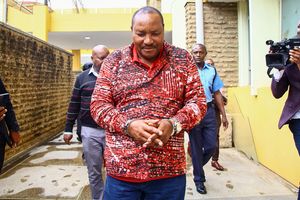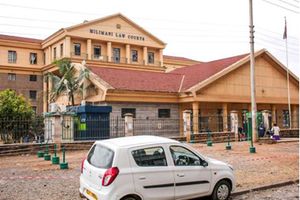Premium
Numbers game: Path to victory for Ruto, Raila in polls

People queue to vote during the 2017 elections. A first round win in the August 9, 2022 presidential election can only be achieved if the winner gets at least 8.63 million votes, assuming a voter turnout of at least 78 per cent.
A first round win in the August presidential election can only be achieved if the winner gets at least 8.63 million votes, assuming a voter turnout of at least 78 per cent, a Nation analysis has shown.
But if the voter turnout jumps to the highs of the 2013 polls at 86 per cent, a winner will have to garner at least 9.511 million.
If it drops to the average of the 2013 and 2017 polls’ turnout (82 per cent), the winner will have to poll 9.0694 million votes for a first round win.
In 2013, during a transition election plagued by international politics and the large shadow of the International Criminal Court (ICC) cases facing President Kenyatta and his deputy William Ruto, Kenya recorded a staggering 86 per cent voter turnout.
A total of 12.3 million of the 14.38 million registered voters went to the polls.
Transition election
While it is unlikely that a similar mobilising factor as big as the ICC will recur in the August poll, the fact that it is a transition election could still play a role.
If the voter turnout drops to 70 per cent as it was in 2007, the 50 per cent plus one mark will be achieved if a winner hits at least 7.75 million votes. This tally, however, was before Kenya adopted the 50 per cent plus one vote requirement.
A presidential candidate is declared winner in the first round if one gets at least 50 per cent plus one of the total votes cast and at least 25 per cent in at least 24 of the 47 counties.
In the annulled August 2017 poll when President Kenyatta was seeking re-election against a four-time presidential candidate, Mr Odinga, the country recorded a 78 per cent voter turnout.
This brings an average of 77.96 per cent, if you include 2007, and 82 per cent if you narrowed it down to averages of the two most recent polls of 2013 and 2017.
50 per cent plus one
Allies and strategists of both DP Ruto and his main challenger Odinga have often boasted of what they said are numbers to hit the required 50 per cent plus one vote mark, with both camps having publicly stated a figure of a win with 60 per cent of the total votes, way above the required margin.
With the Independent Electoral and Boundaries Commission (IEBC) having closed the voter register at 22,120,458 voters, the race for a first round win is now on, with both camps crunching numbers to determine where they need to whip out voters to cast their ballot and where they need to put more emphasis in the battlegrounds to tilt the race in their favour.
But in the grand scheme of things, and assuming the Ruto and Odinga perceived strongholds remain intact, the race will be won or lost in the counties identified as battlegrounds.
Infotrak poll
The latest Infotrak poll released two weeks ago placed Mr Odinga and running mate Martha Karua in the lead at 42 per cent against the Ruto-Rigathi Gachagua pair with 38 per cent.
The rest was accounted by a high undecided vote of nearly 20 per cent, with the other two candidates, Prof George Wajackoyah and Mr David Mwaure Waihigia, recording negligible support.
The poll indicated Mr Odinga would garner at least 9.3 million votes with a clear lead in 20 counties against DP Ruto’s 8.4 million votes with victory in 16 counties.
The poll does not compute this as against a projected voter turnout.
Even then, this means the race is in the actual total number of votes, with no possibility that any of the two leading candidates will fail to get the 24-county threshold to be declared winner, were they to get the 50 per cent.
Another poll by Trends & Insights for Africa (Tifa) conducted on May 17 also puts Mr Odinga ahead at 39 per cent against the DP who polled 35 per cent.
First round victory
Both polls indicated that the winner, either Ruto or Odinga, would secure a first round victory unless a strong third party candidate emerged to steal away a fraction to deny either of the Big Two the magic 50 per cent plus one number. The next two months will see rigorous campaigns to win over the many undecided voters which Infotrak puts at 20 per cent, an equivalent of 4.4 million voters.
A poll released yesterday by Tifa, however, showed that there could be a wildcard in the unconventional campaign of ‘legalise ganja’ candidate Prof Wajackoyah. Although the poll was only in Nairobi, the Roots Party flagbearer attaining an impressive seven per cent in a capital city that is a microcosm of Kenya could be highly significant if his appeal is replicated at the national stage.
The 11 counties Infotrak identified as battlegrounds are Tana River, Kwale and Lamu in the Coast region; Turkana, Samburu, Nakuru and West Pokot in the North Rift region; Narok and Kajiado in the South Rift; and Bungoma and Trans Nzoia in Western Kenya.
In Coast, Mr Odinga had 801,031 votes against Mr Kenyatta’s 287,066.
While all the national polls have placed Mr Odinga ahead at the Coast, the DP has since made inroads, winning over Kwale Governor Salim Mvurya and key MPs in the region, and is fielding former governors Issa Timamy (Lamu), Hussein Dado (Tana River), and John Mruttu (Taita-Taveta) for governor, as well as Hassan Omar (Mombasa), Fatuma Achani (Kwale), and Aisha Jumwa (Kilifi), respectively.
Mt Kenya factor
Then there is the Mt Kenya factor and the place of voter turnout in the region.
In the eight Mt Kenya counties, President Kenyatta garnered 3.3 million votes in 2017, which accounted for 40 per cent of his national tally of 8.2 million (54.2 per cent).
If you slice off 30 per cent from the 3.3 million—either due to low voter turnout or Mr Odinga taking a slice off it—it would translate to roughly one million votes.
The effect of the deduction of this figure from President Kenyatta’s basket is to reduce his national tally to 47.8 per cent, which would mean he wouldn’t have notched a first round win.
This is bad news for DP Ruto, who rode on these numbers to a win in 2013 and 2017, having crossed the 50 per cent plus one mark in the former with just 8,000 votes.
Possible runoff
Any slicing of this tally, therefore, not only dents his chances of getting to the UhuRuto numbers in the two previous polls, but also could point to a possible runoff were he to fail to marshal enough numbers in the battlegrounds.
Mr Odinga, on the other hand, is seeking to maintain a lead in Samburu, Turkana, Narok and Kajiado where he had a slim lead against President Kenyatta in 2013 and 2017, or lost narrowly to the Jubilee leader, as he aims to maintain the tally in Nyanza, the 62 per cent in Western, and more than 85 per cent in Wiper leader Kalonzo Musyoka’s Ukambani backyard.
This tally got him to 44.7 per cent in 2017, and inroads in a majority of the 11 battlegrounds, or a substantive chunk of more than one million votes in Central, could tilt him past the 50 per cent mark.
Murang’a governor candidate Irungu Kang’ata—a Ruto ally—Tuesday said the confirmation of a final voters’ roll, which shows the youth at only 8.8 million against 13.3 million of the elderly population, will also inform their messaging, going forward.
“The closure of the register helps us craft right messaging for the most impactful demographic. The new register suggests [a] majority of voters are the elderly. That means matters healthcare must reign supreme in our agenda since that’s their most important imperative. Further, it reveals counties where we need to focus most,” Dr Kang’ata said.
Older generation
Mr Odinga’s strategist, Jubilee director of elections Kanini Kega, was also excited about the fact that the poll will be decided by the older generation.
“There has been a fallacy that majority of the voters are below 35 but this one is very clear that they are above 35. As Azimio, we have been focusing on all the age groups from young to old and that is the reason we have programmes for all. For the Kenya Kwanza team, their focus has been on these young voters and it has become apparent that the young voters would not be the determinants.
“The determining factor will be the aged population. This spells a doom for the UDA. Tyranny of numbers would be with the mature voters. We have capitalised and focused on them to the detriment of Kenya Kwanza,” the Kieni MP said.
He added: “Secondly, the shrinking number of young voters coupled with the [entrance] of George Wajackoyah, who is also targeting the young voters, means that the votes that Ruto and his team were relying on are at huge risk. For us, we are okay and we are good with the numbers.”





